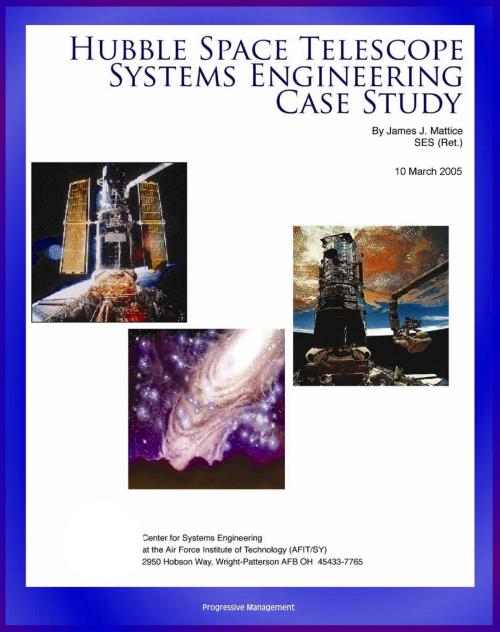Hubble Space Telescope Systems Engineering Case Study: Technical Information and Program History of NASA's Famous HST Telescope
Nonfiction, Science & Nature, Technology, Aeronautics & Astronautics, Science, Physics, Astrophysics & Space Science| Author: | Progressive Management | ISBN: | 9781476036137 |
| Publisher: | Progressive Management | Publication: | July 21, 2012 |
| Imprint: | Smashwords Edition | Language: | English |
| Author: | Progressive Management |
| ISBN: | 9781476036137 |
| Publisher: | Progressive Management |
| Publication: | July 21, 2012 |
| Imprint: | Smashwords Edition |
| Language: | English |
This is one of a series of systems engineering case studies prepared by the Air Force Center for Systems Engineering. This case study analyzes the Hubble Space Telescope program.
The incredible story of the HST program from the early dreams and visions of a space-based telescope in 1946, through extensive, more formal program formulation and developments in the 1970s, tumultuous re-direction in the 1980s (especially due to the impact of the 1986 Challenger disaster), initial launch in 1990, and unplanned major on-orbit repairs in 1993 provides the basis for an exciting case study in all aspects of systems engineering. As we will see, this case represents a program dramatically impacted by a variety of scientific, technical, economic, political, and program management events and factors, many of them unpredictable.
The study provides a wealth of technical information about the project and its complex history.
The Department of Defense is exponentially increasing the acquisition of joint complex systems that deliver needed capabilities demanded by our warfighter. Systems engineering is the technical and technical management process that focuses explicitly on delivering and sustaining robust, high-quality, affordable solutions. The Air Force leadership has collectively stated the need to mature a sound systems engineering process throughout the Air Force. Gaining an understanding of the past and distilling learning principles that are then shared with others through our formal education and practitioner support are critical to achieving continuous improvement.
FOREWORD * ACKNOWLEDGEMENTS * EXECUTIVE SUMMARY * 1.0 SYSTEMS ENGINEERING PRINCIPLES * 1.1 General Systems Engineering Process * 1.2 HST Major Learning Principles * 2.0 SYSTEM DESCRIPTION * 3.0 HST SYSTEMS ENGINEERING LEARNING PRINCIPLES * 3.1 Learning Principle 1 - Early Customer/User Participation * 3.2 Learning Principle 2 - Use of Pre-Program Trade Studies * 3.3 Learning Principle 3 - System Integration * 3.4 Learning Principle 4 - Life Cycle Support Planning and Execution * 3.5 Learning Principle 5 - Risk Assessment and Management * 4.0 SUMMARY * 5.0 REFERENCES
This is one of a series of systems engineering case studies prepared by the Air Force Center for Systems Engineering. This case study analyzes the Hubble Space Telescope program.
The incredible story of the HST program from the early dreams and visions of a space-based telescope in 1946, through extensive, more formal program formulation and developments in the 1970s, tumultuous re-direction in the 1980s (especially due to the impact of the 1986 Challenger disaster), initial launch in 1990, and unplanned major on-orbit repairs in 1993 provides the basis for an exciting case study in all aspects of systems engineering. As we will see, this case represents a program dramatically impacted by a variety of scientific, technical, economic, political, and program management events and factors, many of them unpredictable.
The study provides a wealth of technical information about the project and its complex history.
The Department of Defense is exponentially increasing the acquisition of joint complex systems that deliver needed capabilities demanded by our warfighter. Systems engineering is the technical and technical management process that focuses explicitly on delivering and sustaining robust, high-quality, affordable solutions. The Air Force leadership has collectively stated the need to mature a sound systems engineering process throughout the Air Force. Gaining an understanding of the past and distilling learning principles that are then shared with others through our formal education and practitioner support are critical to achieving continuous improvement.
FOREWORD * ACKNOWLEDGEMENTS * EXECUTIVE SUMMARY * 1.0 SYSTEMS ENGINEERING PRINCIPLES * 1.1 General Systems Engineering Process * 1.2 HST Major Learning Principles * 2.0 SYSTEM DESCRIPTION * 3.0 HST SYSTEMS ENGINEERING LEARNING PRINCIPLES * 3.1 Learning Principle 1 - Early Customer/User Participation * 3.2 Learning Principle 2 - Use of Pre-Program Trade Studies * 3.3 Learning Principle 3 - System Integration * 3.4 Learning Principle 4 - Life Cycle Support Planning and Execution * 3.5 Learning Principle 5 - Risk Assessment and Management * 4.0 SUMMARY * 5.0 REFERENCES















